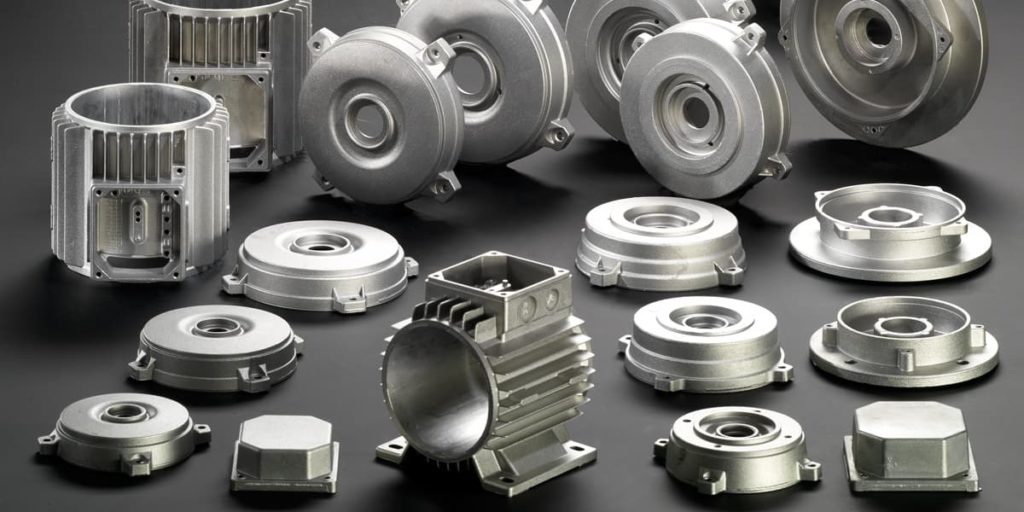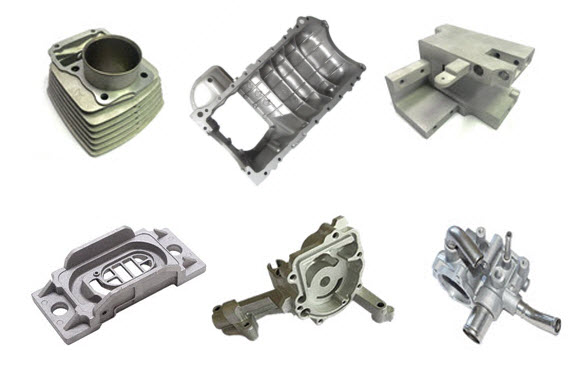How Aluminum Foundry Adds to Ingenious Solutions in Metal Construction
Aluminum factories greatly influence the landscape of metal construction. They embrace innovative casting strategies that boost accuracy and design flexibility. This capability permits the manufacturing of light-weight and durable components that provide to varied market needs. Moreover, the combination of automation and sustainable practices sets a criteria for efficiency. As these factories advance, they question about the future of production and the role of technology in shaping the sector.
The Duty of Aluminum Foundries in Modern Manufacturing
Aluminum shops play a vital function in modern manufacturing, adding significantly to different markets, consisting of automobile, aerospace, and consumer items. These centers focus on the melting and spreading of aluminum, transforming resources right into high-quality components that meet stringent market standards. The lightweight yet solid properties of Aluminum make it a perfect choice for manufacturers aiming to enhance performance while decreasing weight, particularly in the automobile field, where fuel efficiency is paramount.
Light weight aluminum shops use innovative processes to produce intricate shapes and designs that provide to specific market demands. By leveraging advanced modern technologies such as computer-aided design and simulation, these factories can optimize their manufacturing processes and boost product use. This not just improves the high quality of the end products yet additionally reduces waste, contributing to more lasting production practices. Ultimately, the contributions of Aluminum shops are important for driving development and performance across several markets.
Advanced Spreading Techniques Changing Steel Construction
Advanced spreading methods are reinventing the field of metal construction, particularly through accuracy casting methods that boost precision and minimize waste. Innovative alloy advancements are also playing an essential function, allowing for tailored homes and improved performance in numerous applications. Together, these innovations are setting new requirements in performance and quality within Aluminum factories.
Accuracy Casting Techniques
As the demand for premium parts in different industries remains to climb, accuracy spreading approaches have actually become a transformative force in metal fabrication. These techniques, including financial investment casting, lost foam spreading, and pass away spreading, permit detailed geometries and limited resistances that conventional methods usually have a hard time to accomplish. By using innovative materials and modern technologies, accuracy casting decreases waste and improves performance, enabling suppliers to create complex parts with minimized lead times. In addition, these methods offer premium surface area coatings and mechanical residential or commercial properties, making them perfect for sectors such as aerospace, auto, and clinical gadgets. As makers increasingly adopt accuracy spreading, the capability to meet specific design needs while maintaining cost-effectiveness becomes an essential advantage in today's competitive market.
Innovative Alloy Developments
Innovative alloy growths are improving the landscape of metal fabrication, especially within the domain of accuracy casting. Advancements in product scientific research have actually resulted in the production of specialized Aluminum alloys that boost resistance, sturdiness, and stamina to corrosion. These novel alloys enable foundries to create detailed elements with boosted mechanical residential or commercial properties, catering to diverse industries such as aerospace, automobile, and electronics. The unification of advanced spreading strategies, including die spreading and sand spreading, additional optimizes the use of these products, enabling complex geometries and decreased waste. Consequently, makers are better geared up to satisfy strict performance standards while lessening ecological impact. Ultimately, these cutting-edge alloys are leading the way for a new age of performance and sustainability in metal fabrication.
Light-weight and Resilient: The Benefits of Aluminum Components
Aluminum components use considerable advantages in various applications as a result of their light-weight nature and sturdiness. This mix adds to enhanced fuel performance, specifically in the auto and aerospace sectors. Additionally, light weight aluminum's integral rust resistance additionally extends the life expectancy of items, making it a favored selection in many metal construction processes.
Enhanced Gas Performance
While typical products have long been the criterion in various sectors, the shift in the direction of Aluminum parts is changing the landscape of metal fabrication, particularly in connection with enhanced gas performance. Aluminum's lightweight nature significantly reduces the total weight of vehicles and machinery, enabling enhanced performance and minimized energy consumption. This reduction in weight converts directly to lower gas intake, making Aluminum an appealing choice for manufacturers aiming to meet stringent environmental laws. Additionally, light weight aluminum's durability guarantees that parts keep their honesty gradually, adding to lasting performance. As markets significantly prioritize sustainability, the adoption of Aluminum components ends up being a strategic selection, lining up functional objectives with environmental obligation while improving gas efficiency in numerous applications.
Deterioration Resistance Advantages
Among the standout features of Aluminum components is their outstanding corrosion resistance, which significantly boosts the long life and reliability of numerous applications. This home is specifically beneficial in rough environments, such as marine and commercial setups, where direct exposure to dampness and chemicals can bring about significant destruction in various other steels. Unlike steel, Aluminum normally creates a safety oxide layer that serves as click to investigate an obstacle against environmental components, minimizing the risk of corrosion and deterioration. Consequently, Aluminum elements need much less upkeep and have a longer service life, making them an economical choice for producers. This integral toughness not only adds to the total performance of products yet additionally supports sustainability efforts by decreasing the need for constant substitutes.
Innovations in Design and Design Via Aluminum Foundries
As improvements in Aluminum Foundry innovation remain to improve the landscape of steel construction, cutting-edge layout and design options are emerging to satisfy the demands of diverse markets. The versatility of Aluminum enables for intricate designs that were previously unattainable with typical materials. Foundries are leveraging computer-aided design (CAD) software program and simulation tools to enhance the style process, making it possible for engineers to produce light-weight yet robust elements tailored to certain applications.
The capability to integrate innovative alloying methods permits the modification of Aluminum buildings, enhancing stamina and sturdiness. This adaptability fosters creativity in item advancement, enabling companies to explore new shapes and structures that boost performance while reducing weight. Collaborative initiatives in between factories and designers help with rapid prototyping, resulting in shorter project timelines and raised general effectiveness. These developments not just enhance product performance however likewise drive sustainability by lessening product waste during the manufacture procedure.
Enhancing Performance With State-Of-The-Art Modern Technology
Innovations in state-of-the-art innovation are transforming the efficiency of Aluminum shops, simplifying processes from layout to production. Automation plays a crucial role, with robot systems boosting the speed and accuracy of tasks such as molding, pouring, and ending up. These automated remedies decrease human mistake and decrease labor expenses, while additionally increasing outcome consistency.
Furthermore, the integration of innovative software program for computer-aided style (CAD) and simulation enables fast prototyping and testing, quickening the shift from concept to production. Foundries are utilizing real-time data analytics to keep an eye on operations, making certain peak efficiency and minimizing downtime.
Moreover, 3D printing innovation is being embraced for developing intricate mold and mildews and elements, decreasing material waste and lead times. The mix of these sophisticated technologies not only boosts performance but likewise boosts the quality of Aluminum products, placing shops at the forefront of development in steel fabrication.
Sustainable Practices in Aluminum Foundries
A growing number of Aluminum foundries are taking on lasting techniques to minimize their environmental effect and promote source efficiency. Aluminum Castings. These factories are significantly carrying out reusing programs, where scrap Aluminum is accumulated and recycled, significantly reducing waste. Additionally, energy-efficient modern technologies, such as electrical furnaces and advanced insulation products, are being made use of to lower energy intake during the melting procedure
Water preservation techniques are likewise acquiring traction, with numerous shops recycling water in cooling systems to lower overall usage. The adoption of green coatings and additives lessens damaging exhausts without compromising product high quality.
Future Fads in Aluminum Spreading and Metalworking
Progressively, the future of Aluminum casting and metalworking is being shaped by technological developments and progressing market criteria. Innovations in automation and robotics are enhancing processes, boosting precision, and decreasing labor prices. The adoption of additive production methods, such as 3D printing, is changing traditional spreading approaches, permitting complex geometries and decreased material waste.
Additionally, the combination of synthetic knowledge and data analytics is making it possible for real-time monitoring and anticipating upkeep, which optimizes production efficiency. Sustainability continues to be a core emphasis, with firms buying green methods, including the recycling of Aluminum scrap and the usage of renewable this article resource sources in manufacturing.
As the need for lightweight, long lasting products in numerous markets rises, Aluminum factories should adjust by developing innovative alloys and improving casting methods. These fads jointly aim to a future where Aluminum casting and metalworking are more efficient, sustainable, and responsive to market needs.

Often Asked Inquiries
What Sorts Of Aluminum Alloys Are Typically Made Use Of in Foundries?
Typically used Aluminum alloys in shops include 2xxx collection (copper), 3xxx series (manganese), 4xxx series (silicon), 5xxx collection (magnesium), and 6xxx series (magnesium and silicon), each offering unique buildings appropriate for different applications.
Just How Does Aluminum Spreading Compare to Various Other Steel Construction Approaches?
Aluminum casting deals advantages such as reduced look these up production prices and complex forms contrasted to standard fabrication techniques. It gives excellent dimensional accuracy and surface area finish, making it a favored option for several markets over choices like machining or welding.
What Security Procedures Are Applied in Aluminum Foundries?
Aluminum factories apply different safety procedures, consisting of personal safety devices, ventilation systems, normal safety and security training, risk assessments, and emergency methods to shield workers from risks connected with liquified steel, warm, and potential chemical exposure. Wisconsin Aluminum Foundry.
Exactly How Can Firms Find Reliable Aluminum Foundry Allies?
Business can determine dependable Aluminum Foundry companions by examining market online reputation, evaluating client testimonials, assessing high quality certifications, taking into consideration production capabilities, and conducting site brows through to assure alignment with their details requirements and criteria.

What Is the Regular Lead Time for Aluminum Spreading Projects?
The typical preparation for Aluminum casting projects varies from two to 8 weeks, relying on factors such as style intricacy, production volume, and the shop's ability to meet certain task needs and timelines.
Aluminum foundries play a crucial role in modern-day production, adding significantly to various sectors, including automotive, aerospace, and customer items. As advancements in Aluminum Foundry technology continue to reshape the landscape of metal manufacture, ingenious design and design services are arising to meet the needs of diverse sectors. Improvements in state-of-the-art modern technology are reinventing the performance of Aluminum foundries, streamlining processes from design to manufacturing (Aluminum Foundry). A growing number of Aluminum foundries are adopting lasting methods to reduce their ecological influence and promote resource effectiveness. As the demand for light-weight, sturdy materials in numerous industries rises, Aluminum shops need to adapt by creating cutting-edge alloys and enhancing spreading strategies